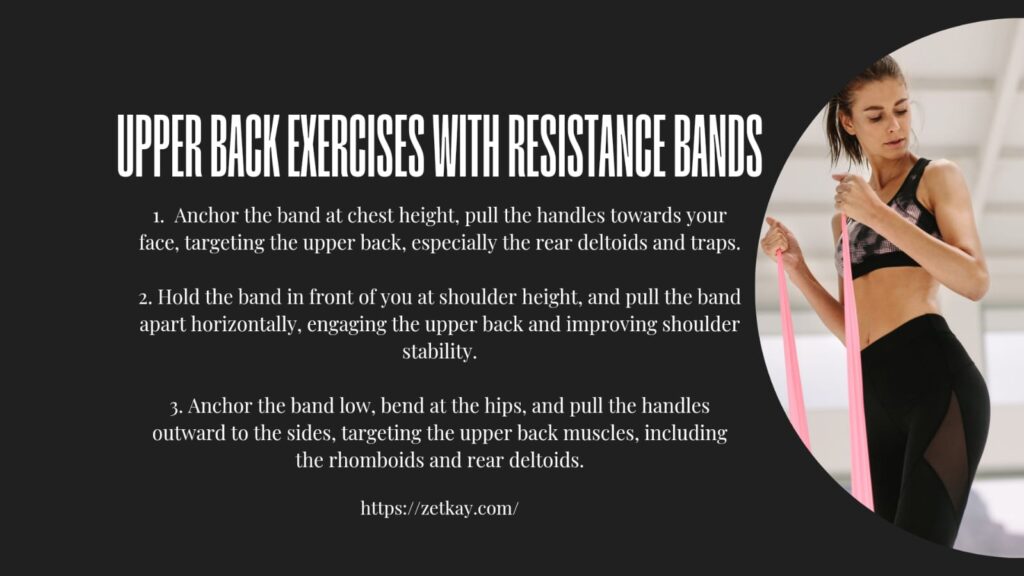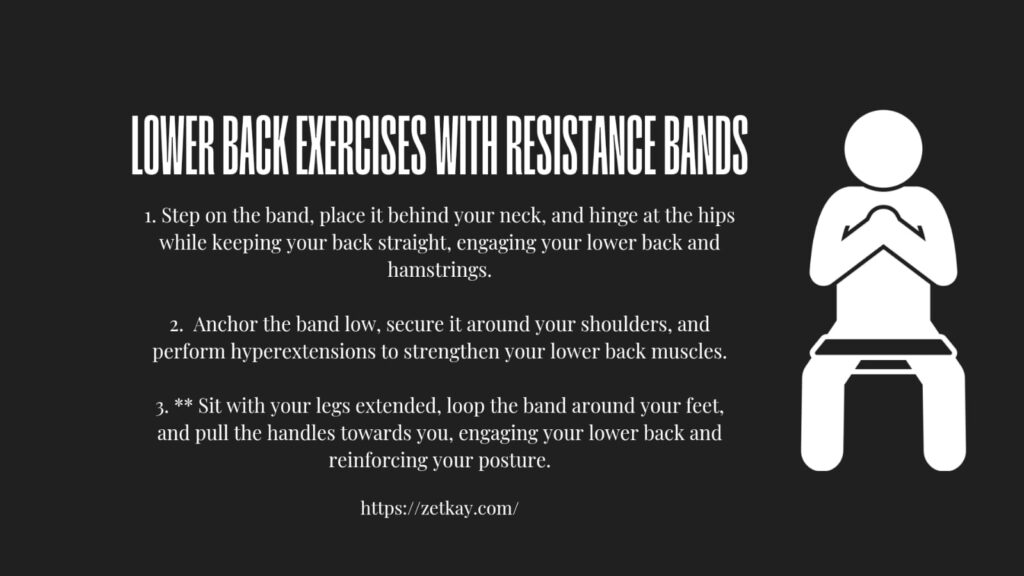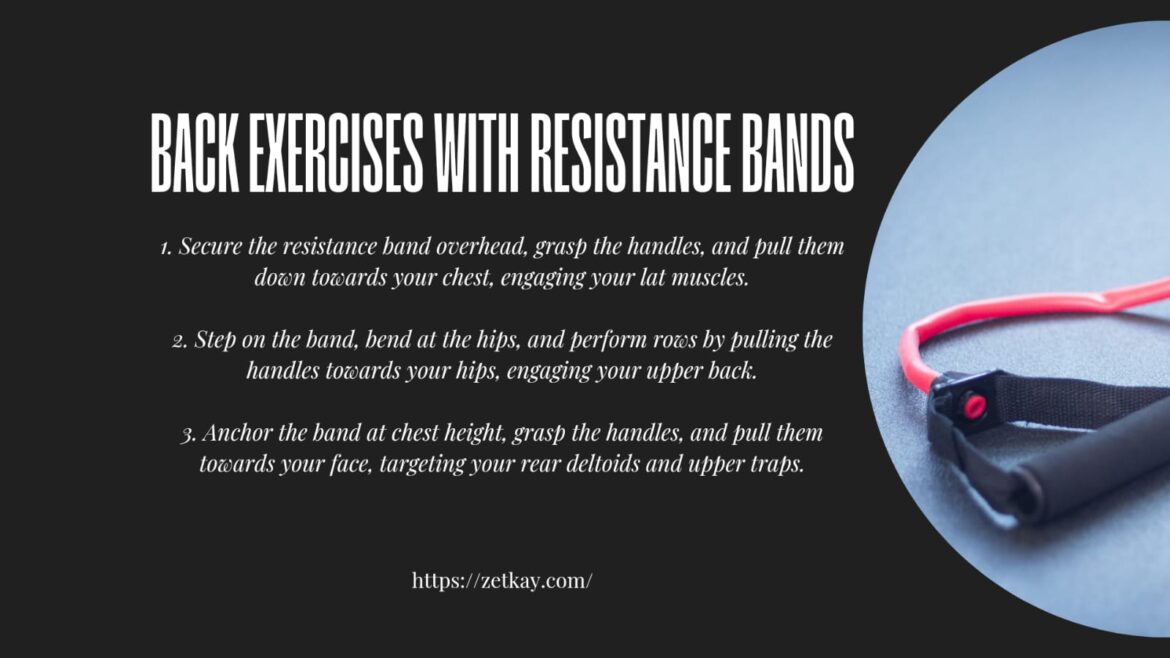Back exercises with resistance bands are necessary for the final guide to bracing your back with the power of resistance bands! Maintaining a strong and healthy back is necessary for well-being in today’s fast-moving world.
If you’re a fitness expert looking to take your workouts to the next level or someone searching for help for back pain, “Back Exercises with Resistance Bands” including back exercises with resistance bands into your daily routine can be a good idea.
These variable bands offer moveable resistance levels, making them suitable for all fitness levels and allowing you to change your workout to your physical needs.
Join us as we jump into back exercises with resistance bands and search for effective moves that will help you model a stronger, more strong back while boosting your pose and decreasing the risk of injury.
Introduction:
In today’s inactive lifestyle, back pain has become progressively common. If it’s from long hours sitting at a work surface or enhanced lifting methods, many people feel back pain.
But back exercises with resistance bands can be a research tool for this issue. These flexible tools offer moveable resistance levels, making them acceptable for all fitness levels, and allow you to tailor your workout to your particular needs.
We’ll inspect a change of back exercises using resistance bands, their profit, and how you can include them in your fitness procedure.

Back exercises with resistance bands:
Change your back with selective exercises using resistance bands. These flexible tools offer moveable resistance levels, making them better for anyone looking to reinforce their back muscles and improve their overall fitness.
Upper back exercises with resistance bands:
Resistance bands are good tools for selecting the upper back muscles, helping to boost pose and reduce tension. Here are some successful exercises to include in your daily routine:
- Banded Rows: Attach the resistance band to a stable presenter, such as a door holder. Grasp the ends of the band with each hand and step back to create tension. Pull the band towards your chest and compress your shoulder cutters together as you row.
- Reverse Flyes: Stand with your feet wind-up apart and hold the resistance band in front of you with both hands, fists facing each other. Keep a slight bend in your elbows, open your arms out to the sides, and press your shoulder cutters together at the top of the move.
- Lat Pulldowns: Safe the resistance band above, such as on a solid flash or stop bar. Bow or stand and grasp the ends of the band with both hands. Draw the band down towards your chest, attracting your back and upper back muscles.
Plus, these exercises, including stretches and strength instruction, can increase the power of your upper back workout with resistance bands.
Extending the chest and shoulders can help prevent the effects of extended sitting and screen time, while strength exercises can boost the range of motion and increase the risk of cuts. Contain these exercises into your daily routine to build a strong and hardy upper back that supports proper pose and whole-body

Lower back exercises with resistance bands:
Include back exercises with resistance bands into your daily routine can help successfully attack the muscles of the lower back, boost safety, and decrease the risk of cuts. Here are some key exercises to try:
- Deadlifts: Stand on the resistance band with your feet apart, saving the ends of the band with both hands. Keep your back straight and basic as you hinge at the hips and lower the band towards the ground. Back to the standing position.
- Superman Pulses: Be face down on the ground with the resistance band winding around your feet. Expand your arms above and lift your chest and legs off the ground together, attracting your lower back muscles. Beat up and down for added power.
- Bird Dogs: Begin on your hands and knees with the resistance band winding around one foot and gripping the opposite hand. Expand your arm and leg out straight, and keep a flat back and tight basic. Redo to the starting position and redo on the other side.
By including these exercises in your daily routine, you can brace your lower back muscles, increase spinal stability, and increase the risk of pain and cuts. To focus on proper form and technique to reduce the advantages of resistance band training for the lower back.

Back exercises with resistance bands for seniors:
Using resistance bands for back exercises provides seniors with a safe and successful way to build power without putting uncontrolled strain on the joints. These exercises can be easily changed to help individual fitness levels and power, making them right for beginners and trained exercisers alike.
- Seated Rows: Sit on a chair with your legs expanded and the resistance band firmly tied up in front of you. Hold the ends of the band with both hands, fists facing each other, and pull the band towards your body. Press your shoulder cutters together.
- Lat Pulldowns: Firm the resistance band overhead. Sit on a chair or safety ball with a good pose. “Back exercises with resistance bands” grip the ends of the band and pull them down towards your chest, agreeable to your lat muscles.
- Back Extensions: Be face down on a mat with the resistance band winding around your feet and held safely in your hands. Lift your chest and legs off the ground together, keeping your neck in a constant position.
- Band Pull-Aparts: Stand tall with your feet shoulder-width apart and support the resistance band in front of you with your arms. Pull the band apart horizontally, and compress your shoulder cutter together as you do so.
- Superman with Band: Be face down on a runner with the resistance band winding around your heels. Lift your chest and legs off the ground together, and extend your arms forward. Hold for a few seconds before overcasting back down.
Benefits of Resistance Band Training for the Back:
Resistance band training, with its adaptability to “back exercises with resistance bands,” offers many benefits for back growth, including:
- Versatility: The use of resistance bands allows for many exercises to select different muscle groups in the back, giving an oversearching workout experience.
- Portability: Unlike bulky gym tools, resistance bands are lightweight and easily moveable, making them ideal for home workouts or when traveling.
- Joint-Friendly: Resistance bands offer solid tension around the range of motion, increasing stress on joints’ balance with free weights.
- Scalability: If you’re a beginner or a trained lifter, resistance bands can be converted to meet different fitness levels and goals. Check for effective back exercises with resistance bands.

Resistance Band Lat Pulldowns:
- Take the resistance band to a solid above the moor.
- Hold the band with an overarm catch, hands looser than shoulder-width apart.
- Pull the band down towards your chest, attract your lats, and compress your shoulder cutter together.
- Steadily return to the starting position with control.
- Perform 3 sets of 12–15 recaps.
Resistance Band Rows:
- Fix the resistance band around a solid object at middle height.
- Stand facing the moor point with feet shoulder-width apart.
- Grip the band with an overarm hold; your arms will expand in front of you.
- Pull the band around your body, retract your shoulder cutters, and press your back muscles.
- Steadily return to the starting position and control.
- Perform 3 sets of 12–15 recaps.

Resistance Band Superman:
- Be face down on the ground with the resistance band winding around your feet.
- Grip the hold or wind with an overarm hold.
- Lift your chest and legs off the ground together according to your back muscles.
- Hold them for a few seconds, then lower them back down with control.
- Perform 3 sets of 10–12 recaps.
Tips for Maximizing Results:
To maximize the value of your back workouts with resistance bands, consider the following tips:
- Focus on Form: keep proper form all over each exercise to check you’re selecting the planned muscle groups and minimizing the risk of cutting.
- Progressive Overload: Slowly increase the resistance or repeat over time to regularly challenge your muscles and help growth.
- Include Variety: Mix up your back workouts by including different exercises and resistance band changes to stop the level and keep your workouts attractive.
- Listen to your body: Pay attention to how your body responds to the exercises, and balance the resistance or volume correctly to avoid overtraining.
- Recovery and Nutrition: Confirm you’re getting enough rest and nutrition to support muscle healing and growth, as well as hydration.
Conclusion:
With back exercises with resistance bands, you now have the knowledge and tools to shape a strong, defined back with the support of your own home or gym. By including these exercises in your daily workout routine and following the tips for boosting results, you can unleash your full power and realize your fitness goals. ” back exercises with resistance bands” So grasp your resistance bands and get ready to take your daily workouts to the next level!
FAQS:
What are some effective resistance band exercises for targeting the upper back muscles?
Back exercises with resistance bands, such as band stripdowns, face pulls, and rows, successfully select the upper back muscles, giving adaptability and being good for at-home or gym workouts
